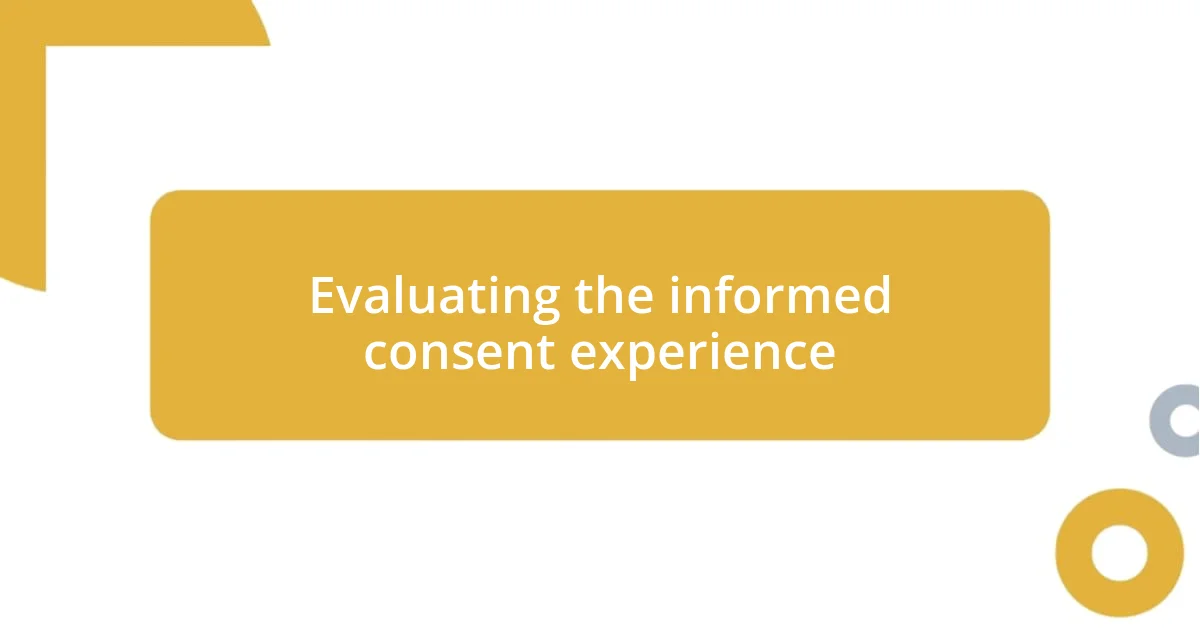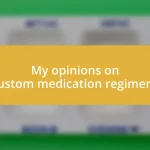Key takeaways:
- The informed consent process emphasizes respect, communication, and building trust between patients and healthcare providers.
- Key elements include clarity, voluntariness, and comprehension, ensuring patients understand their choices without feeling pressured.
- Evaluating the consent experience involves creating a supportive environment, actively seeking feedback, and recognizing the importance of emotional and cultural factors in understanding medical information.

Understanding informed consent process
The informed consent process is fundamentally about respect and communication. I remember sitting in a doctor’s office, nervously awaiting a procedure, and the physician took the time to explain not just what would happen, but why it was necessary. This moment made me realize—how often do we just skim over these details? It’s vital to truly understand what we’re agreeing to.
When I think back to that experience, I see how the burden lifted when I could ask questions freely. Have you ever felt overwhelmed by medical jargon? Clear explanations and compassionate conversations can transform what might be a daunting experience into one where you feel empowered and in control of your decisions.
Ultimately, informed consent is about building trust. In my view, when health professionals genuinely engage with its importance, patients are more likely to feel supported. This goes beyond just signatures on a form; it’s about creating a partnership where both parties are involved in the decision-making process. Don’t you think that would lead to better health outcomes?

Key elements of informed consent
The key elements of informed consent revolve around clarity, voluntariness, and comprehension. While I’ve encountered forms that seem overwhelming, I appreciate when healthcare providers present information in a straightforward manner. During a recent visit, the nurse used simple language to explain my options, which helped me feel empowered in my decision-making.
Equally important is the aspect of voluntariness. I once faced pressure during a consultation; the provider suggested one option strongly, but I felt it was my right to explore others. It reassured me when I insisted on discussing alternatives, reflecting how crucial it is for patients to feel free from coercion when making healthcare choices.
Lastly, comprehension ties everything together. I can’t recall a moment more impactful than when a doctor paused to check if I understood each component of my treatment plan. This approach not only deepened my trust but affirmed that informed consent is a collaborative journey. A true partnership thrives when both parties invest time in understanding each other.
| Key Element | Description |
|---|---|
| Clarity | Information presented in an understandable way. |
| Voluntariness | Patients are free from coercion to make their decisions. |
| Comprehension | Ensuring patients fully understand the information given. |

Effective communication in consent
Effective communication is the backbone of the informed consent process. I recall a time when a specialist took extra care to explain the intricacies of a procedure—from potential risks to the expected outcomes. This attention to detail made me not just a passive participant but an active one, fostering a sense of ownership over my health choices. It reminded me that communication should not be a monologue; instead, it’s about nurturing a dialogue where questions are welcomed.
When I reflect on those moments, I realize the importance of adapting our communication styles. Some patients might benefit from visual aids, while others might prefer in-depth discussions. Here are a few strategies I find effective in promoting clear communication during the consent process:
- Encourage Questions: Create an open atmosphere by inviting questions at every stage.
- Use Layman’s Terms: Simplify medical terminology without dumbing it down; it helps demystify complex ideas.
- Summarize Key Points: Regularly recap important information to reinforce understanding and retention.
By integrating these strategies, I believe both patients and providers can engage more meaningfully, ensuring informed consent truly reflects a shared decision-making process.

Overcoming barriers to consent
I’ve often found that social and cultural barriers can significantly impact the consent process. For instance, during a family member’s healthcare journey, we discovered that their background influenced their understanding of medical terminology. This realization prompted me to ask the physician to rephrase explanations, emphasizing the need for cultural sensitivity. How can we ensure patients from diverse backgrounds fully grasp their options? Tailoring our approach, we can break down these barriers.
Another obstacle I’ve encountered involves emotional factors. Patients may feel overwhelmed or anxious about their condition. I remember sitting next to a friend who appeared lost during a complex discussion about treatment options. Recognizing this, I encouraged him to pause and take a breath before asking his doctor to clarify a few points. This moment highlighted the critical need to create a supportive environment where emotions are acknowledged, allowing informed choices to flourish.
Technological advancements can also pose a challenge in understanding. In a recent telehealth appointment, I struggled to navigate the platform while simultaneously trying to comprehend the information being shared. It made me realize the importance of simple user interfaces and tech-friendly guidance. Providers must ensure that technological tools enhance, rather than hinder, the informed consent experience by offering walkthroughs and support for those less tech-savvy. How can we bridge this gap? By focusing on user-friendliness, we can empower patients to engage fully.

Best practices for obtaining consent
Obtaining informed consent goes beyond just a signature on a form; it’s about cultivating trust. I remember a consultation where the physician sat down with me, allowing me ample time to process information. This creates an environment where I felt comfortable admitting when something was unclear. It makes me wonder—how often do we overlook the importance of patience in these discussions? Taking the time to ensure genuine understanding can significantly enhance the consent process.
Another best practice I’ve found valuable is utilizing teach-back methods. During one of my visits, a doctor asked me to explain back how I understood the information regarding a new medication. It was an eye-opener for both of us; any gaps in my understanding were quickly addressed. This technique not only confirms comprehension but also empowers patients by making them active participants in their care. Could we all benefit from this approach? Absolutely. It encourages dialogue and emphasizes collaboration in health decisions.
Lastly, documentation plays a crucial role in ensuring clarity throughout the consent process. In my experience, clear records of discussions, including questions asked and answers given, can serve as reference points for both patient and provider. I once received a follow-up message from a healthcare provider summarizing our earlier consent discussion, which reinforced my comfort level and confidence in the decision made. Isn’t it reassuring to have a safety net of information back at your fingertips? It’s these small yet impactful actions that can transform the landscape of informed consent into a more supportive and effective practice.

Legal considerations in informed consent
When it comes to informed consent, legal considerations are paramount. I recall a situation where a friend underwent a surgical procedure, and we discovered that understanding the legal implications of consent forms is crucial. These documents often contain detailed information about risks and rights, and I felt a wave of anxiety when I realized that many patients, including myself, might skim through them without fully comprehending their significance. How often do we pause to dissect the language used in these agreements? Taking the time to truly understand these forms can safeguard against misunderstandings later.
There’s also the aspect of capacity, which is essential in the legal framework of informed consent. I remember attending a health seminar where the speaker emphasized that not all patients may be in a position to grant informed consent—whether due to age, cognitive ability, or the acute nature of an illness. This led me to think about my own encounters with elderly relatives who occasionally struggled to grasp medical complexities. It raises an important question: Who advocates for those unable to fully advocate for themselves? Ensuring that proper guardians or advocates are involved can provide a safety net for those vulnerable patients.
Moreover, the concept of voluntary consent cannot be overlooked. I had a poignant moment during a discussion with a colleague about how coercion can sometimes creep into the consent process, often without anyone realizing it. For example, when healthcare providers unconsciously exert pressure during decision-making, the integrity of consent is compromised. It’s a stark reminder that consent should always be given freely, without fear of repercussions for asking questions or saying no. How do we cultivate an environment where patients feel genuinely empowered to voice their concerns? By consciously working to create a culture of openness and respect, we can significantly enhance the informed consent experience for all involved.

Evaluating the informed consent experience
Evaluating the informed consent experience requires looking beyond mere procedural tasks. I remember feeling a mix of relief and frustration during a medical appointment where the consent process felt rushed. It forced me to ask: How does the pace at which we deliver information affect a patient’s understanding? After all, when doctors treat consent as just another checkbox, the essence of informed decision-making gets lost amidst the paperwork.
I often reflect on how the physical and emotional environment impacts the informed consent experience. In a busy clinic, with rushed staff and constant interruptions, I felt like a cog in a machine. However, during a later visit to a different provider, the care team ensured a calm atmosphere that encouraged my questions. Why does that matter? Because when patients feel their concerns are valued, they engage more deeply, and the quality of consent improves significantly.
Finally, it’s essential to consider feedback loops in evaluating the informed consent experience. When I’ve had the chance to share my thoughts post-consent, it’s felt therapeutic. I once filled out a survey after a procedure, sharing how the process could have been clearer. Imagine if more healthcare providers actively sought this feedback—how might that reshape informed consent? My experience shows that fostering a culture of continuous improvement can truly enhance this critical dialogue between patients and providers.














